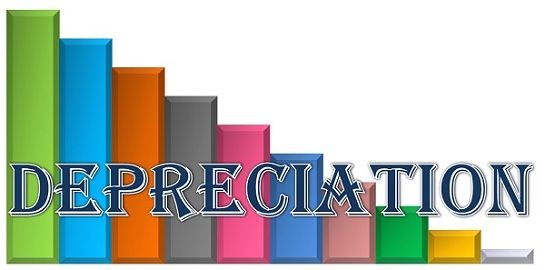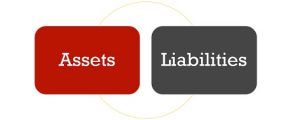 In accounting glossary, the term depreciation is often used, for writing off the value of the asset over its useful life. It is nothing but the decrease in the value of the fixed asset because of continuous use, the passage of time and technological obsolescence. There are nine different methods of calculating depreciation of assets out of which straight line method and written down value method is widely used. In straight line method (SLM), an equal amount of depreciation is written off every year.
In accounting glossary, the term depreciation is often used, for writing off the value of the asset over its useful life. It is nothing but the decrease in the value of the fixed asset because of continuous use, the passage of time and technological obsolescence. There are nine different methods of calculating depreciation of assets out of which straight line method and written down value method is widely used. In straight line method (SLM), an equal amount of depreciation is written off every year.
Conversely, in written down value method (WDV), there is a fixed rate of depreciation which is applied to the opening balance of the asset every year. So, here we are going to throw light on the difference between SLM and WDV methods.
Content: SLM Vs WDV
Comparison Chart
| Basis for Comparison | SLM | WDV |
|---|---|---|
| Meaning | A method of depreciation in which the cost of the asset is spread uniformly over the life years by writing off a fixed amount every year. | A method of depreciation in which a fixed rate of depreciation is charged on the book value of the asset, over its useful life. |
| Calculation of depreciation | On the original cost | On the written down value of the asset. |
| Annual depreciation charge | Remains fixed during the useful life. | Reduces every year |
| Value of asset | Completely written off | Not completely written off |
| Amount of depreciation | Initially lower | Initially higher |
| Impact of repairs and depreciation on P&L A/c | Increasing trend | Remains constant |
| Appropriate for | Assets with negligible repairs and maintenance like leases, copyright. | Assets whose repairs increase, as they get older like machinery, vehicles etc. |
Definition of Straight Line Method
A method of depreciation in which a fixed amount is written off year on year, during the useful life of the asset, to reduce the value of the asset to zero or its scrap value at the end of its useful life is a straight line method. In this method, the cost of the asset is uniformly spread over the lifetime of the asset. This method is also known as fixed instalment method.
Under this method, a particular asset is expected to generate equal utility (economic benefits) during its useful life. Although this is not possible in all circumstances.
The rate of depreciation can be calculated with the following formula:
Definition of Written Down Value Method
The depreciation method in which a fixed percentage of the reducing balance is written off every year as depreciation, to reduce the fixed asset to its residual value at the end of its working life. This method is also known as reducing balance or diminishing balance method where the annual charge of depreciation keeps on decreasing every year.
So the depreciation charged in the initial years is higher as compared to the subsequent years. Although, according to this method the value of the asset is not fully extinguished.
The following formula is used to determine the rate of depreciation under this method:
Key Differences Between SLM and WDV
The difference between SLM and WDV are explained in the given below points in detail
- SLM is a method of depreciation in which the cost of the asset is spread uniformly over the life years by writing off a fixed amount every year. WDV is a method of depreciation in which a fixed rate of depreciation is charged on the book value of the asset, over its useful life.
- In straight-line method, depreciation is calculated on the original cost. On the other hand, in the written down value method, the calculation of depreciation is on the basis of written down value of the asset.
- The annual depreciation charge in SLM remains fixed during the life of the asset. In contrast, the amount of depreciation in WDV method diminishes every year.
- In straight line method, the book value of the asset is completely written off i.e. the asset value is reduced to zero or its salvage value. Conversely, the asset’s book value is not completely written off in written down value method.
- If a firm is using SLM method, then the amount of depreciation is initially lower while if the method of depreciation is WDV then in the beginning the amount of depreciation is higher.
- The SLM method is best for the fixed assets with negligible repairs and maintenance like leases. On the contrary, WDV method is appropriate for the fixed assets whose repairs increase, as they get older like machinery, vehicles, etc.
- The impact of repairs and depreciation on the P&L account can be easily understood by an example – We all know it is natural that as the asset gets older, the amount of repairs and maintenance, increase year on year. Now look at the given situation:
SLM
WDVYear Depreciation Repairs Amount debited in P&L A/c 1 10000 2000 12000 2 10000 4000 14000 3 10000 6000 16000 4 10000 8000 18000
Year Depreciation Repairs Amount debited to P&L A/c 1 10000 2000 12000 2 8000 4000 12000 3 6000 6000 12000 4 4000 8000 12000
So with this example, it is quite clear that the method of depreciation affects the profit.
Conclusion
As we all know that depreciation is a non-cash expense which does not result in a cash outflow yet it is debited to the profit and loss account as it reflects the correct income measurement and actual financial position. The income tax authorities prefer written down value method over the straight line method.






Arunkumar says
Such a wonderful definition that what i need to know is furnished. thank you.
Zeeshan says
Great explanation.
Kudos!
Alok says
thanks
Kishan says
Nice definition